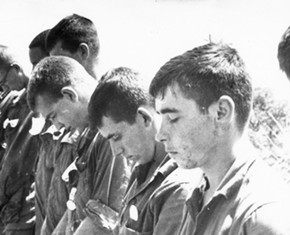The views expressed in our content reflect individual perspectives and do not represent the authoritative views of the Baha'i Faith.
We have the great privilege of living in the age of the written word, especially when it comes to the world’s newest global religion, the Baha’i Faith.
In previous ages, the words of the messengers of God were most often passed down from generation to generation by word of mouth, becoming the oral tradition of a people until they were finally written down – often centuries later. The words of Jesus were recorded in the Gospels of the Bible by his disciples long after he had died. Jesus spoke to people and they remembered what he said. There is no indication that Jesus could read or write, nor did he need to. He was a teacher of men’s hearts, and the principle means of communication in his lifetime was verbal.
In the Baha’i Faith, meticulous effort has been made to gather together the writings of Baha’u’llah and preserve the original text written in his own hand. Baha’is are fortunate to have such authoritative texts. This in itself will avoid the confusion which other religions have had to face in the past concerning what were or were not the actual words of the founders of their Faiths.

Baha’u’llah continued to write during his entire ministry while in prison and in exile. The sum total of his books, tablets, and epistles numbers more than a hundred volumes. He wrote many of them to specific individuals in response to questions asked of him. He composed each missive in the language and vocabulary the recipient understood, and within the literary style he would recognize. To an Islamic theologian, Baha’u’llah wrote in terms of Qur’anic law and the traditions of the hadith; to a Christian clergyman, he employed biblical concepts and symbols; to a Sufi, he spoke in the style of mystic symbolism; to a political ruler, he chose direct and didactic words.
Regardless of their intended recipient, Baha’u’llah’s books are at once personal and universal. They not only answer the enquirers’ questions and satisfied their particular needs, but at the same time each missive reveals knowledge appropriate to all humankind. Baha’u’llah wrote on a wide spectrum of subjects: social justice, the history of religion, war and peace, practical and applied ethics, morality, spirituality, economics, social organization, human rights, jurisprudence, the arts, metaphysics, science, mysticism, and prophecy.
Some of the better known works of Baha’u’llah include The Hidden Words, a book of brief moral and spiritual aphorisms unlike any other religious book, itself a new genre of literature. It is composed of 153 proverb-like utterances which beautifully present the depths of religious understanding in general, the spiritual truths at the heart of all religions. It is wisdom wrapped in brevity. It was revealed in two parts, the first in Arabic and the second in Persian, each language reflecting a style of literature and having a flavor all its own:
This is that which hath descended from the realm of glory, uttered by the tongue of power and might, and revealed unto the Prophets of old. We have taken the inner essence thereof and clothed it in the garment of brevity, as a token of grace unto the righteous, that they may stand faithful unto the Covenant of God, may fulfill in their lives His trust, and in the realm of spirit obtain the gem of Divine virtue. – Baha’u’llah, The Hidden Words, p. 3.
Baha’u’llah’s The Seven Valleys has been described as the summit of achievement in the realm of mystical composition. In this timeless and placeless description of the inner verities of religion, Baha’u’llah employed the terminology of the twelfth-century Sufi Faridu’d-Din Attar to describe the stages on the mystic path along which the seeker must travel towards God. These seven stages or valleys as Baha’u’llah refers to them are: the Valley of Search, the Valley of Love, the Valley of Knowledge, the Valley of Unity, the Valley of Contentment, the Valley of Wonderment, and the Valley of True Poverty and Absolute Nothingness.
The Four Valleys is an epistle written in Baghdad, and like The Seven Valleys is a mystical composition in which Baha’u’llah describes the four ways in which the traces of the unseen Creator can be perceived, the four stages of the human heart, and the four kinds of mystic seeker in the quest for God.
Baha’u’llah’s Book of Certitude presents the continuum of divine revelation across the ages. It describes and affirms the common thread running through all religions, and the connection that unifies all of the messengers and prophets, who Baha’u’llah refers to as the “divine Luminaries” and the “Suns of Truth”:
… by the “sun” in one sense is meant those Suns of Truth Who rise from the dayspring of ancient glory, and fill the world with a liberal effusion of grace from on high. These Suns of Truth are the universal Manifestations of God in the worlds of His attributes and names. Even as the visible sun that assisteth, as decreed by God, the true One, the Adored, in the development of all earthly things, such as the trees, the fruits, and colours thereof, the minerals of the earth, and all that may be witnessed in the world of creation, so do the divine Luminaries, by their loving care and educative influence, cause the trees of divine unity, the fruits of His oneness, the leaves of detachment, the blossoms of knowledge and certitude, and the myrtles of wisdom and utterance, to exist and be made manifest. Thus it is that through the rise of these Luminaries of God the world is made new, the waters of everlasting life stream forth, the billows of loving-kindness surge, the clouds of grace are gathered, and the breeze of bounty bloweth upon all created things. It is the warmth that these Luminaries of God generate, and the undying fires they kindle, which cause the light of the love of God to burn fiercely in the heart of humanity. – Baha’u’llah, The Book of Certitude, pp. 33-34.
Baha’u’llah’s Most Holy Book outlines the laws and ordinances Baha’is follow in this new age:
While in prison We have revealed a Book which We have entitled “The Most Holy Book.” We have enacted laws therein and adorned it with the commandments of thy Lord Who exerciseth authority over all that are in the heavens and on the earth. Say: Take hold of it, O people, and observe that which hath been set down in it of the wondrous precepts of your Lord, the Forgiving, the Bountiful. It will truly prosper you both in this world and the next and will purge you of whatsoever ill beseemeth you. He is indeed the Ordainer, the Expounder, the Giver, the Generous, the Gracious, the All-Praised. – Baha’u’llah, Tablets of Baha’u’llah, p. 262.
The Epistle to the Son of the Wolf was the last major volume revealed by Baha’u’llah, addressed to the son of the man who was instrumental in the execution of many Baha’is and whom Baha’u’llah had named “The Wolf.” In this Epistle, Baha’u’llah summarizes the Baha’i Revelation in passages like this:
The utterance of God is a lamp, whose light is these words: Ye are the fruits of one tree, and the leaves of one branch. Deal ye one with another with the utmost love and harmony, with friendliness and fellowship. He Who is the Daystar of Truth beareth Me witness! So powerful is the light of unity that it can illuminate the whole earth. The One true God, He Who knoweth all things, Himself testifieth to the truth of these words. – Baha’u’llah, Epistle to the Son of the Wolf, p. 14.
This series of essays is adapted from Joseph Roy Sheppherd’s book The Elements of the Baha’i Faith, with permission from his widow Jan Sheppherd.
















Comments
Sign in or create an account
Continue with Googleor